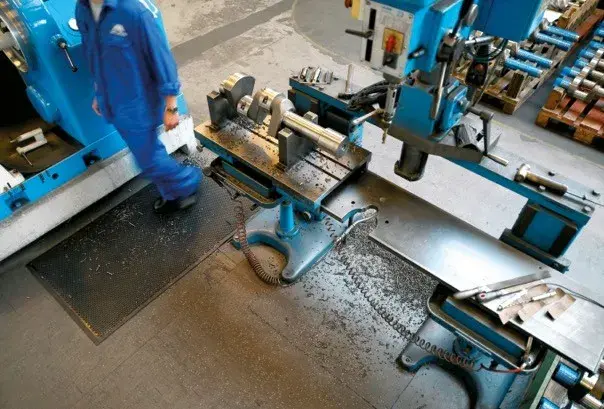
Standing for long periods reduces concentration
Employees in many crafts, manufacturing professions and in commercial kitchens often stand in one place for very long periods - often 6 hours or more a day. With serious consequences: Those who stand for long periods become tired and unable to concentrate, as the body and brain are not supplied with sufficient oxygen and nutrients due to the lack of blood circulation. Other common complaints are
- Headache,
- perceptual disorders,,
- disturbances of fine motor skills and
- longer reaction times.
This can become an accident risk - for example, when employees have to operate machines.
Stress on the body at work when standing for long periods
Standing also damages the body enormously in the long term. Muscles, joints, ligaments, tendons and veins are under constant strain. The blood cannot flow properly and thus cannot supply the body with nutrients. Painful cramps, tension and hardening of the muscles are the result. Standing for long periods can also lead to foot and leg pain: Heel pain, a heel spur or the feeling of having heavy legs are common. In the long term, varicose veins or even thromboses can develop.
The spinal discs suffer
The spinal discs also suffer from long periods of standing. They are not supplied with enough blood themselves. Therefore, they have to draw the nutrients that are important for them - oxygen and glucose - from the surrounding tissue. However, they can only do this if they are regularly loaded and unloaded, as they can then fill up like a sponge or release fluid. The more often we change our posture between standing, sitting, walking and lying down, the better we take care of our intervertebral discs. Monotonous standing, on the other hand, (as well as prolonged sitting) leads to the intervertebral discs being constantly under pressure and unable to absorb nutrients.
Risk of disc herniation
The result: they lose their elasticity and become brittle and cracked. This affects the mobility of the entire spine: it can no longer properly absorb shocks and impacts. Chronic changes often occur in the intervertebral discs and vertebral bodies, which can lead to nerve dysfunction, lumbago or a slipped disc. In this case, the viscous interior of the spinal disc is pressed outwards through a tear in the connective tissue sheath. The result: severe pain or even paralysis.

Designing a health-friendly standing workplace
Companies can reduce the health burden on their employees by simple means. This starts with the design of the job profile:
- Ideally, standing and sitting activities should alternate.
- If a task does not allow for this, job rotation or additional tasks for a staff member can be considered.
- Standing aids can also help to relieve employees - but care must be taken to ensure that there is enough space for the aids. Since they are mostly used at production tables, these should be height-adjustable so that ergonomic working is possible.
Anti-fatigue mats for healthy standing
According to the Federal Institute for Occupational Safety and Health, resilient floor coverings are also very helpful. They reduce joint and spine fatigue at standing workplaces. In addition, they have a heat-insulating effect and thus protect against cold feet. Such a covering can also be easily integrated at a later date, for example in the form of anti-fatigue mats from CWS. The medically tested special mat reacts to minimal physical movement and relieves the leg and back muscles as well as the joints. A health-promoting effect that the American Podiatric Medical Association (APMA) has tested and found to be good.
Thanks to the relief, the blood circulation is stimulated and thus fatigue and loss of performance of the employees is reduced. The non-slip mat made of 100 % nitrile rubber is easy to clean and has an antistatic effect. It is available in four sizes for optimal workplace equipment.

Creating healthy standing workplaces
In many occupations, long periods of standing will be unavoidable. However, the health and economic consequences of these activities can be minimised. Employers, in particular, have the leeway to maintain the performance of their employees by changing activities or by equipping workplaces with standing aids or anti-fatigue mats.
